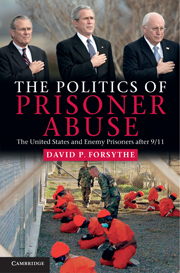Book contents
- Frontmatter
- Contents
- Preface
- List of abbreviations and acronyms
- 1 Torture and political morality in historical perspective
- 2 Political morality and the Bush Administration
- 3 Bush lawyers: the politics of legal interpretation
- 4 The military: Afghanistan, Guantánamo, Iraq
- 5 The CIA: kidnapping, Black Sites, extraordinary rendition
- 6 Due process: detention classification, Military Commissions
- 7 Prisoner abuse and the politics of transitional justice
- Annex A Cast of principal characters
- Annex B Reports on US policy toward enemy prisoners
- Annex C Some relevant legal norms: selected provisions
- Annex D Timeline, selected events, Bush Administration
- Index
- References
4 - The military: Afghanistan, Guantánamo, Iraq
Published online by Cambridge University Press: 05 June 2012
- Frontmatter
- Contents
- Preface
- List of abbreviations and acronyms
- 1 Torture and political morality in historical perspective
- 2 Political morality and the Bush Administration
- 3 Bush lawyers: the politics of legal interpretation
- 4 The military: Afghanistan, Guantánamo, Iraq
- 5 The CIA: kidnapping, Black Sites, extraordinary rendition
- 6 Due process: detention classification, Military Commissions
- 7 Prisoner abuse and the politics of transitional justice
- Annex A Cast of principal characters
- Annex B Reports on US policy toward enemy prisoners
- Annex C Some relevant legal norms: selected provisions
- Annex D Timeline, selected events, Bush Administration
- Index
- References
Summary
The CIA has always operated to a significant degree outside the law. The military, by contrast, is at its core an institution committed to discipline and order, strictly governed by the laws of war. So the fact that illegal abusive tactics were officially authorized at the Pentagon's highest levels is in some sense more shocking than the CIA's crimes. We should expect more of the military.
(David Cole, “What to Do About the Torturers?,” New York Review of Books, January 15, 2009)As long as the United States – or any state, for that matter – has the power to detain at pleasure and in secret, abuse of detainees is inevitable.
(Michael Ignatieff, in Kenneth Roth et al., eds., Torture, New York: The New Press, 2005, p. 23)As the previous chapters have showed, when the United States used military force in Afghanistan in the Fall of 2001 and then opened the Guantánamo prison facility in January 2002, it deconstructed the international legal framework for the protection of prisoners in war, even as it declared a Global War on Terror (GWOT). The result was extensive abuse of prisoners, much of it intended by high policy makers. Iraq was supposed to be different, since the George W. Bush Administration declared the 1949 Geneva Conventions fully applicable to a situation of armed invasion and occupation, including those provisions pertaining to prisoners. But Iraq was not fundamentally different in 2003–2005.
- Type
- Chapter
- Information
- The Politics of Prisoner AbuseThe United States and Enemy Prisoners after 9/11, pp. 95 - 135Publisher: Cambridge University PressPrint publication year: 2011

